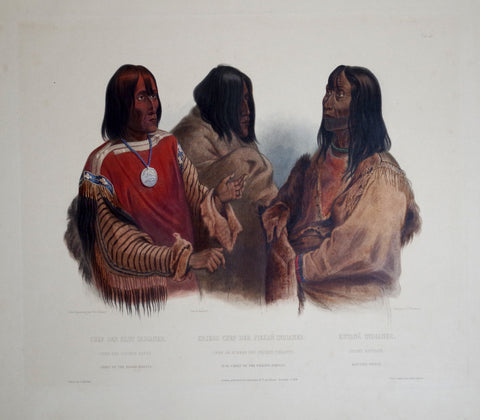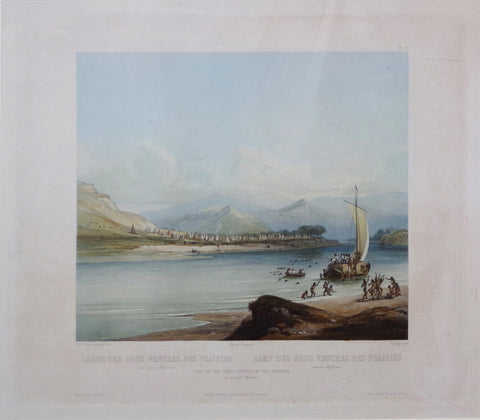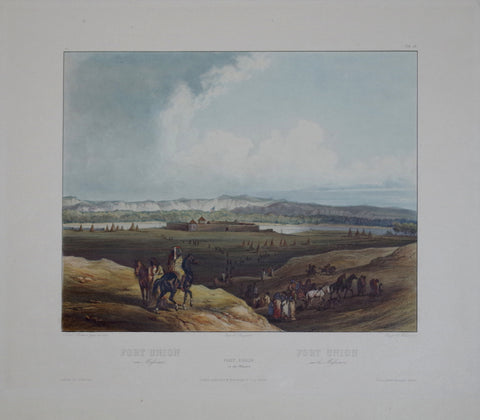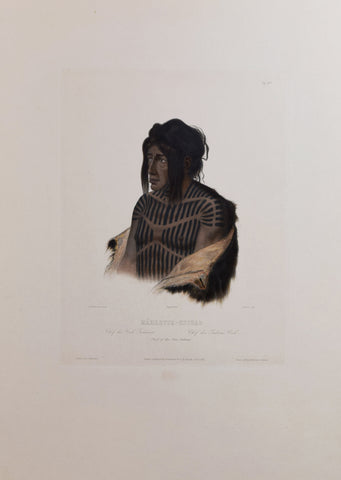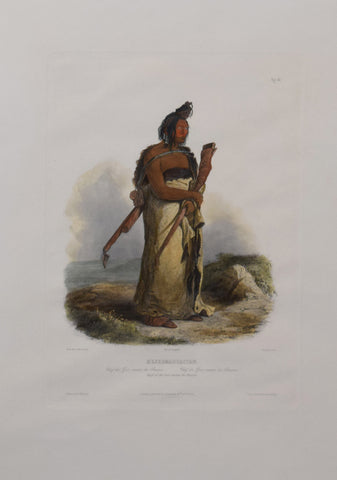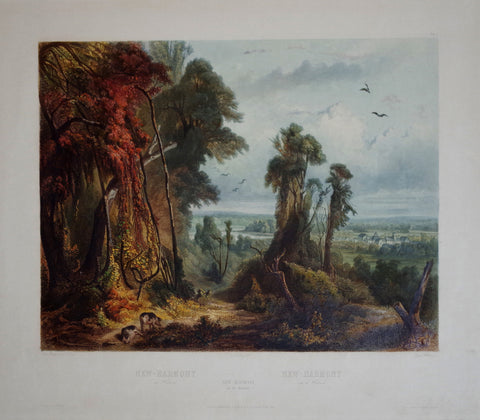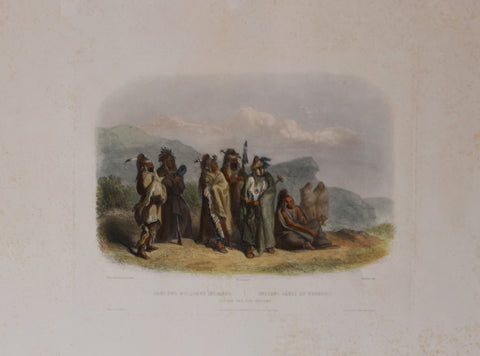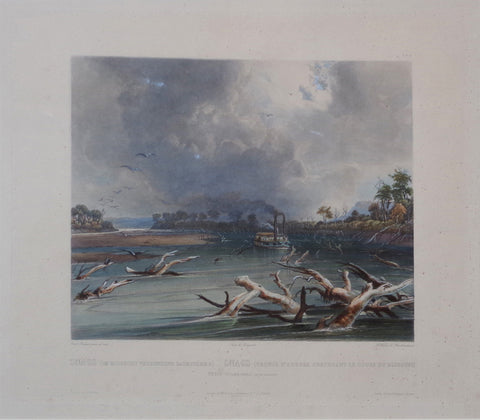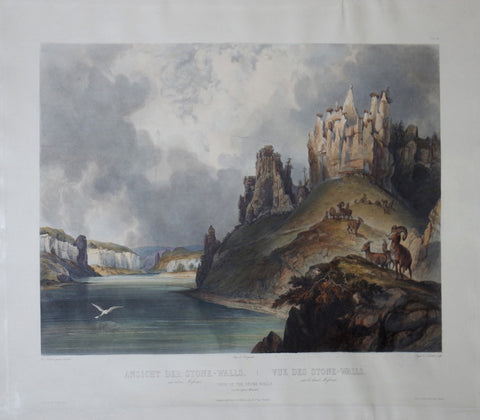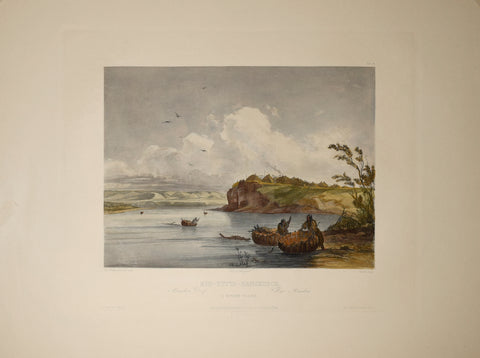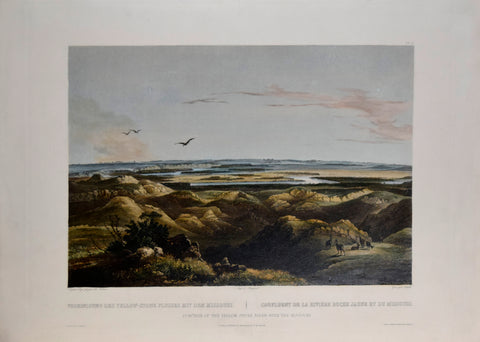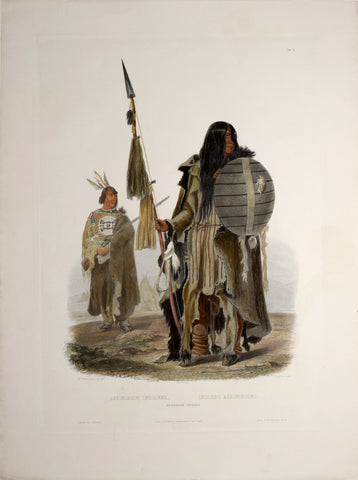Search By Artist
Karl Bodmer (1809-1893)
Karl Bodmer (1809-1893)
Travels in the Interior of North America
Paris amd Coblenz, 1839-1843
Aquatint engraving with original hand-coloring
Karl Bodmer was a little-known Swiss painter when he was chosen by Prince Maximilian of Prussia to accompany his voyage to America, in order to document in pictorial terms the expedition. With the rest of Maximilian’s company, the two traveled among the Plains Indians from 1832 to 1834, a time when the Plains and the Rockies were still virtually unknown. They arrived in the West before acculturation had begun to change the lives of the Indians, and Bodmer, who was a protegé of the great naturalist von Humboldt, brought a trained ethnologist’s eye to the task. The Bodmer/Maximilian collaboration produced a record of their expedition that is incontestably the finest early graphic study of the Plains tribes.
Maximilian and Bodmer journeyed from St. Louis up the Missouri River on the American Fur Company steamboat “Yellowstone,” stopping at a series of forts built by the Fur Company and meeting their first Indians at Bellevue. The travelers continued on another steamboat, “Assiniboin,” to Fort Union, where they met the Crees and Assiniboins. The expedition spent its first winter at Fort Clark, where the Mandans in particular excited Bodmer’s attention, although he was also to draw the Minatarri and Crow peoples. The explorers continued by keelboat to Fort Mackenzie, which proved to be the westernmost point of their journey. After living among and studying the Blackfeet for several weeks, Maximilian decided that it was too dangerous to continue, so the travelers returned southward, reaching St. Louis in May 1834.
After the conclusion of the journey, Bodmer spent four years in Paris supervising the production of the aquatints made from his drawings. These prints rank with the finest Western art in any medium, and they are the most complete record of the Plains Indians before the epidemics of the mid-19th century had decimated their numbers, and before the white man’s expansion had taken their lands. In contrast to other artist-explorers of the 19th century, such as George Catlin, Bodmer was well-trained in the classic European tradition. The work that he did in America is considered to be the high point of a distinguished career. Perhaps more significant, the plates made from Bodmer's sketches were the first truly accurate images of the Plains Indians to reach the general public. Because the 1837 smallpox epidemic killed more than half the Blackfeet and almost all the Mandans, Bodmer’s visually striking work, together with prince Maximilian’s detailed studies of these tribes, form the primary accounts of what became virtually lost cultures. These spectacular and atmospheric images are important and beautiful records of the landscape of the American West as it appeared when Bodmer saw it, just before westward expansion took hold and began the indelible transformation of the frontier.
Travels in the Interior of North America
Paris amd Coblenz, 1839-1843
Aquatint engraving with original hand-coloring
Karl Bodmer was a little-known Swiss painter when he was chosen by Prince Maximilian of Prussia to accompany his voyage to America, in order to document in pictorial terms the expedition. With the rest of Maximilian’s company, the two traveled among the Plains Indians from 1832 to 1834, a time when the Plains and the Rockies were still virtually unknown. They arrived in the West before acculturation had begun to change the lives of the Indians, and Bodmer, who was a protegé of the great naturalist von Humboldt, brought a trained ethnologist’s eye to the task. The Bodmer/Maximilian collaboration produced a record of their expedition that is incontestably the finest early graphic study of the Plains tribes.
Maximilian and Bodmer journeyed from St. Louis up the Missouri River on the American Fur Company steamboat “Yellowstone,” stopping at a series of forts built by the Fur Company and meeting their first Indians at Bellevue. The travelers continued on another steamboat, “Assiniboin,” to Fort Union, where they met the Crees and Assiniboins. The expedition spent its first winter at Fort Clark, where the Mandans in particular excited Bodmer’s attention, although he was also to draw the Minatarri and Crow peoples. The explorers continued by keelboat to Fort Mackenzie, which proved to be the westernmost point of their journey. After living among and studying the Blackfeet for several weeks, Maximilian decided that it was too dangerous to continue, so the travelers returned southward, reaching St. Louis in May 1834.
After the conclusion of the journey, Bodmer spent four years in Paris supervising the production of the aquatints made from his drawings. These prints rank with the finest Western art in any medium, and they are the most complete record of the Plains Indians before the epidemics of the mid-19th century had decimated their numbers, and before the white man’s expansion had taken their lands. In contrast to other artist-explorers of the 19th century, such as George Catlin, Bodmer was well-trained in the classic European tradition. The work that he did in America is considered to be the high point of a distinguished career. Perhaps more significant, the plates made from Bodmer's sketches were the first truly accurate images of the Plains Indians to reach the general public. Because the 1837 smallpox epidemic killed more than half the Blackfeet and almost all the Mandans, Bodmer’s visually striking work, together with prince Maximilian’s detailed studies of these tribes, form the primary accounts of what became virtually lost cultures. These spectacular and atmospheric images are important and beautiful records of the landscape of the American West as it appeared when Bodmer saw it, just before westward expansion took hold and began the indelible transformation of the frontier.

